
The RyanNavion is a single-engine, unpressurized, retractable gear, four-seat aircraft originally designed and built by North American Aviation in the 1940s. It was later built by Ryan Aeronautical Company and the Tubular Steel Corporation (TUSCO). The Navion was envisioned as an aircraft that would perfectly match the expected postwar boom in civilian aviation, since it was designed along the general lines of, and by the same company which produced the North American P-51 Mustang.
The Aeronca Model 9 Arrow was a low-wing all-metal cabin monoplane with retractable landing gear. It was marketed to returning pilots from World War II and unveiled in 1947 but never went into production.

The Alaparma Baldo was an unusual two-seat light monoplane produced in Italy shortly after World War II. Designed by Adriano Mantelli, it featured an egg-shaped fuselage with cabin doors that hinged upwards and to the back. The conventional tailplane with single fin and rudder was carried on twin booms, either side of a pusher engine installation. The undercarriage consisted of a single mainwheel under the fuselage pod, a small tailwheel not far behind it, and outrigger wheels on the wingtips.

The Call-Air Model A is an American two- to three-seat utility aircraft designed by the Call brothers and built by the Call Aircraft Company, later developed into a successful line of agricultural aircraft.

The Funk Model B was a 1930s American two-seat cabin monoplane designed by Howard and Joe Funk. Originally built by the Akron Aircraft Company later renamed Funk Aircraft Company.
The Falconar AMF-S14 Maranda is a two-seat, light aircraft first flown in Canada in 1961 and originally marketed for amateur construction by Falconar Avia.

The FMA 20 El Boyero ("Shepherd") was a light utility aircraft produced in Argentina in the 1940s. It was a conventional high-wing strut-braced monoplane with fixed tailskid undercarriage with seating for two side by side in an enclosed cabin.

The Kellett XR-10 was a military transport helicopter developed in the United States in the 1940s that only flew in prototype form. It was designed in response to a USAAF Technical Instruction issued for the development of a helicopter to transport passengers, cargo, or wounded personnel within an enclosed fuselage. Kellett's proposal followed the general layout that the company was developing in the XR-8, with twin intermeshing rotors, and was accepted by the Air Force on 16 October over proposals by Sikorsky, Bell, and Platt-LePage.
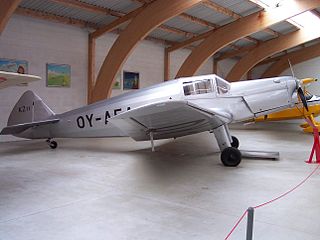
The SAI KZ II was a sport aircraft built in Denmark in 1937, produced in three major versions before and after the Second World War.
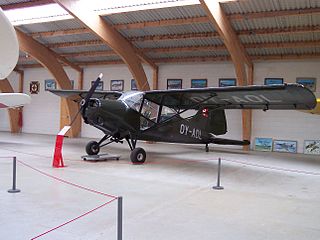
The SAI KZ X was a light aircraft produced in Denmark for army co-operation duties in the early 1950s.
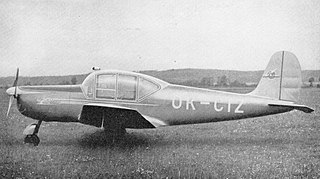
The Mráz M-3 Bonzo was a light aircraft built in Czechoslovakia in 1948 as a further development in the family of light aircraft that had commenced with the M-1 Sokol. The Bonzo was based on the Sokol airframe, but with a redesigned wing and substantial changes to the fuselage. These included lengthening it to allow for the addition of a fourth seat, reducing the height of the rear fuselage to allow for a new cabin with all-around visibility, and the addition of a semi-retractable nosewheel in place of a tailwheel.
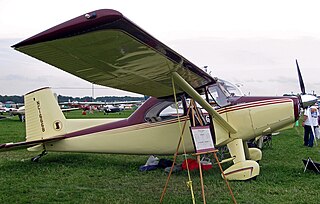
The Luscombe 11 Sedan is a civil utility aircraft produced in the United States in the late 1940s.
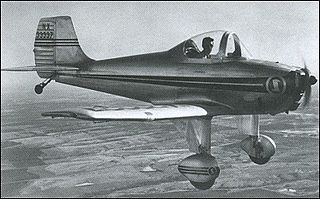
The Luscombe 10 was a single-seat sport aircraft built in the United States in 1945. It was a conventional, low-wing cantilever monoplane with fixed, tailwheel landing gear, designed for aerobatics. The wings, tail unit, and engine section were all adapted from the Luscombe 8, while the fuselage center section was an all-new design, relocating the Model 8's wings from a high to low position.

The Meyers MAC-125 is a light sport aircraft developed in the United States in 1947, produced in a small series as the MAC-145.

The SECAN SUC-10 Courlis was a French high-wing touring monoplane designed and built by Société d'Etudes et de Construction Aéronavales (SECAN), a branch of the automobile company Société des Usines Chaussons. The aircraft had problems with the engine installation and only 144 were built, some without engines and were scrapped.
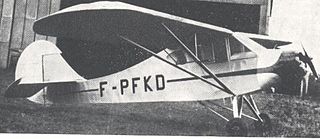
The Adam RA-15 Major was a French sporting plane developed and produced in the decade after World War II.
The SNCAC Chardonneret were a short series of 1940s French three- and four-seat cabin monoplanes with the same wings and general layout but with different engines.

The Fuji LM-1 Nikko is a Japanese light communications aircraft of the 1950s.

The Ambrosini Rondone is an Italian-designed two/three-seat light touring monoplane of the early 1950s.
The Waco Model W Aristocraft was an American four-seat monoplane, the last aircraft designed and built by the Waco Aircraft Company. It had an unusual configuration with an engine mounted at the front driving a pusher propeller at the rear.
















